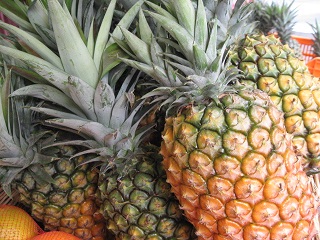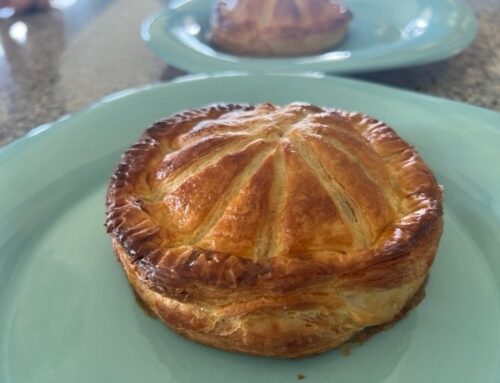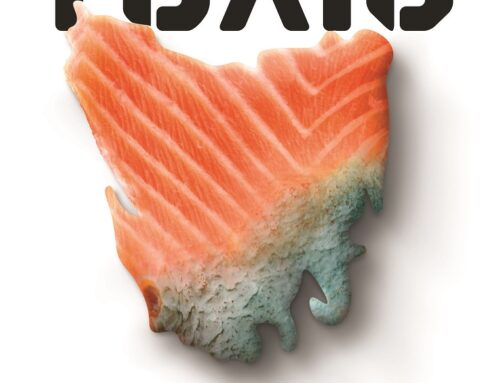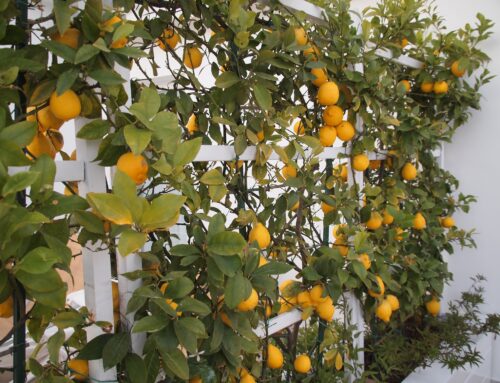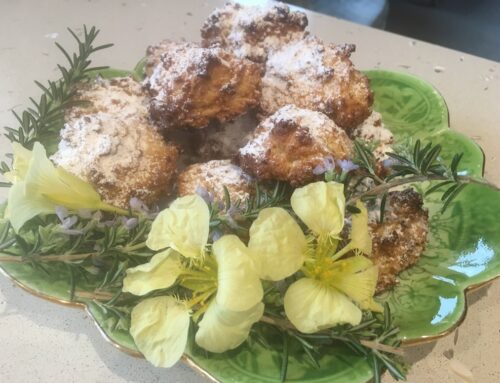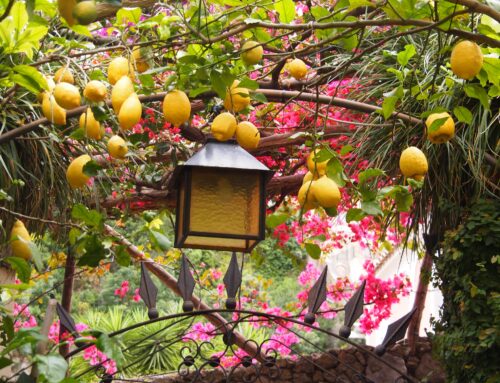Pineapple, Ananas comosus, is a wonderful tropical fruit belonging to the Bromeliad family. Originally from Brazil and parts of tropical South America, they have been growing for thousands of years. Two popular varieties are McGregor’s Queen Pineapple Ananas comosus ‘Queen’, which has prickly leaves and serrated edge leaves that indicate its wild pineapple ancestry. The fruit is small but with a beautiful flavour that can be eaten all the way through without removing the core. Ananas comosus ‘Mareeba Gold’ is a large, sweet fleshy variety that is excellent for juice.
I love our locally grown, delicious Sunshine Coast pineapples – they are fragrant, sweet, rich in vitamin C and potassium, with an intense flavour and great value for money. ‘Ours’ taste so much better than the ones available down south! They are eaten fresh and unadorned, in fruit salads and tarts; prepared in a variety of ways for savoury salads, salsas, sweet and sour Chinese dishes, grilled or fried with ham or chicken; puréed for sorbets and drinks; chopped and used in cakes and pies. Glacé pineapple features in our On the Ridge Christmas cakes. A recent seafood class made a pineapple, cucumber, coriander, onion and chilli salsa as an accompaniment to barbequed snapper; fresh pineapple, prepared in a variety of ways, is frequently teamed with our home-made ice cream. A very special summer dessert is our pineapple and mango cream pithivier – check the Recipe Collection for the recipe.
Cooking with Pineapples
In cooking, it is useful to know that pineapples contain several active protein-digesting enzymes. These are used in meat tenderisers, and can cause problems in other prepared dishes. Bromelain, the major enzyme, will break down gelatin, so pineapple for gelatin-based desserts must be cooked first, to inactivate the enzyme. If pineapple is incorporated into a mixture containing milk or cream, bromelain will break down the casein proteins and produce bitter-tasting protein fragments. Again, precooking the pineapple will prevent this.
Pineapples are commercially grown mainly for canning and juice, however canning reduces the vitamin C level by half. Pineapples also make an interesting, attractive and useful plant in the garden or in a pot.
Our Sunshine Coast climate is ideal for growing pineapples – hence our ‘Big Pineapple’ and many other plantations around here. They require a warm, sunny and frost-free climate if grown outdoors. A northern aspect is best to obtain maximum sunlight. They are grown throughout the year with harvest peaks in January to February and again in June to August.
How do you grow pineapples?
Pineapples are propagated vegetatively by using slips, suckers or the leafy top, or crown, of the fruit. Whenever I cut up a pineapple, I remove the leafy top and plant it about 5cm deep in the garden. Simply cut the top off close to the fruit, remove the bottom leaves; leave it upside down to dry out for a few days. Before planting, dip it into a solution of 1% Captafol to prevent fungal infection. When planting, fertilise with about 30g of slow release fertiliser, such as blood and bone and then monthly with 20g of N:P:K and 5g of Epsom salts. Pineapples are best planted in summer so that the fruit, which takes about eighteen to twenty-four months to mature, can be harvested during the summer, when the flavour is at its peak. However, I plant mine whenever I have a pineapple and take pot luck!
Australian fresh fruit trials conducted on pineapples strive for characteristics such as superior eating qualities, better tasting and sweeter, less acidic fruit. These trials have resulted in significant increases in levels of vitamin A and C, giving added health benefits. There are also flavours being developed ranging from the traditional pineapple flavour through to a fruit salad and coconut flavours.
When is the pineapple ripe?
Pineapples do not ripen any further once picked, so it is important to know when a pineapple is ripe. There are many different views on this. A common misconception is that a pineapple is ripe when you can pluck a leaf from its crown, but this has nothing to do with the ripeness. The qualities to look for in a ripe pineapple are bright, fresh looking fruit that has a quarter to half colour. In winter you may select pineapples with more colour. Underneath, the stem should be fresh, rather than dry and withered, and at the top the leaves should be firm, green and fresh. There should be a good, fragrant aroma, heavy in weight and with a resonant sound when the fruit is tapped, which means that the fruit is not over ripe inside. Be aware that some green varieties are fully ripe. The smell of a ripe pineapple is described by Harold McGee, a world-renowned food chemist and scientist, as having a caramel, meaty, clove, vanilla, basil and sherry aroma!
At home, refrigerate your pineapple and use it as soon as possible. Cut off the top and the base; cut the skin off by standing the pineapple on its cut base and cutting downwards, following the curve of the fruit. Carefully remove all eyes by cutting diagonally with a small, sharp stainless steel knife. Lay peeled fruit on its side and slice into rings, then if the core is tough, remove it with a small sharp knife or apple corer. You can also use a special pineapple peeler and a large serrated knife for preparing pineapple rings.
Alternatively, cut the pineapple in half lengthways, then loosen the fruit from the skin, remove it, cut out the core and cut fruit into wedges or chunky cubes. Cut pineapple will store for 3-4 days in the refrigerator in a tightly sealed container.
I wrote this article for the Noosa Hinterliving magazine, February 2009, when I lived on the Sunshine Coast and operated my On the Ridge Cooking School there. As it is summer again and I am writing about the local, seasonal produce. It seemed like a good idea to re-publish t again here in Tonya’s Musings.

